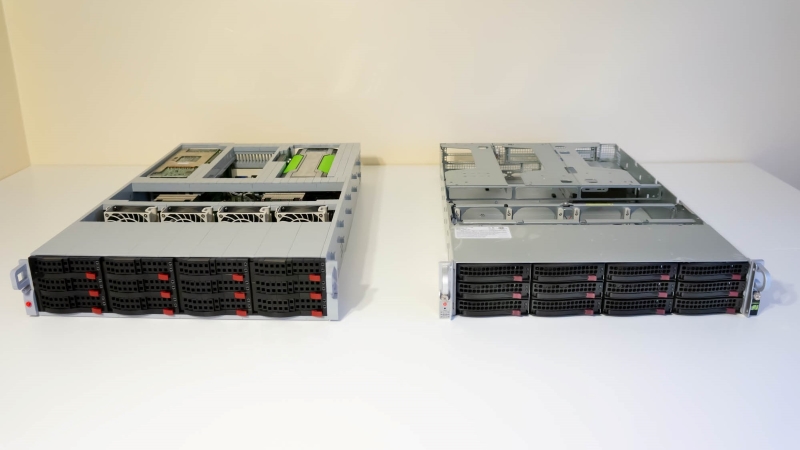The picture above appears to show two unremarkable 2U rack servers, of the kind that are probably hosting the page you’re reading right now. Nothing special there – until you look carefully and realize that the rack server case on the left is made entirely from Lego. And what’s more, the server even works.
When it comes to building Lego computers, [Mike Schropp] is the guy to call. We’ve previously featured his Lego gaming computer, a striking case wrapped around what was a quite capable machine by 2016 standards, as well as an earlier case that reminds us a little of a NeXT. His reputation for Lego-clad computers led server maker Silicon Mechanics to commission a case for a trade show, and [Mike] jumped at the challenge.
Making a home-grade machine is one thing, but supporting all the heavy drives, power supplies, and fans needed to make the machine work is something else. He used a combination of traditional Lego pieces along with a fair sampling of parts from the Lego Technics line to pull off the build, which looks nearly perfect. Sadly, the Lego unit sizes make the case slightly taller than 2U, but that’s a small quibble when everything else matches so well, even the colors. And the fact that the server works, obviously important for a trade show demo, is pretty amazing too. The power supplies are even hot-swappable!
Congratulations to [Mike] on yet another outstanding Lego creation.















Bravo!
Thank you!
“And what’s more, the server even works.”
I wasn’t aware that the case for a computer (or server) was a determining factor in whether the computer (server) worked or not.
Some components like PSUs tend to be heavy, more so when you have 4 of them. Tearing the case apart or bending in half when lifted, moved, or just sitting there would probably fall under ‘not working’
The rack rail tabs are a big deal too, since the rails tend to be a form of telescoping so the server can be pulled fully out of the rack but remain attached and fully support its weight.
TBH I’m rather surprised plastic works there.
Some even have specific air channel designs for heat removal, though that’s a bit more tolerant.
Vibration from poor fitting fans and disks can be killer to spinny drives, and extra loud even without.
One thing I don’t see is if the drive bays are swappable. I guess it would still work fine without that, but would be an annoyance in actual use
My point was a server would still work even if all the parts were connected and laid out on a table without any case at all. So saying the server works even though the case is made of LEGO blocks seems odd.
Probs not as it would over heat very quickly, so the case does play a part.
So if you bought a server, you’ve be fine with all the parts just in a bag, but it turns on would you?
Of course not, there’s a lot more to a working server than just powering on.
Stop being deliberately reductive and facetious.
As Dissy mentioned, the case is often an integral part of determining whether or not the system will function. In this particular instance I needed to ensure all the cooling requirements were satisfied (fans, fan mounts, airflow channels, etc.). As well as the power requirements (psu case connections, connectors, etc.) and boards, drives, and card (Tesla/Phi) mounting requirements were met to make the system functional. Most pre-built computers (HP, Dell, Apple, etc.) have some low level chassis requirements that prevent a system from operating if certain chassis requirements are not met. With server chassis those requirements can be even higher. But overall it was a fun challenge trying to figure out all the ways to meet those requirements with Lego :)
I wouldn’t be that shocked if the cost of the LEGOs + 2 PSUs + backplane was less than the cost of the 2U SuperMicro chassis.
Yes! Spot on! This was a rare case (pun intended) for me where the actual system chassis still cost more than the Lego itself! Normally most of the Lego based computer systems I build end up as such that the Lego costs way more than any regular chassis or case, since it’s a very expensive building material comparatively to most other options. But with this server build the SuperMicro chassis was definitely more expensive than the Lego.
Kudos to the editor for writing Lego, and not Legos, though they would prefer you wrote LEGO bricks :) https://web.archive.org/web/20040903113840/http://www.lego.com/errors/legos.asp?domainredir=legos.com
Hmmm I’d buy a lego box kit for building a SuperMicro server Chassis!! :D